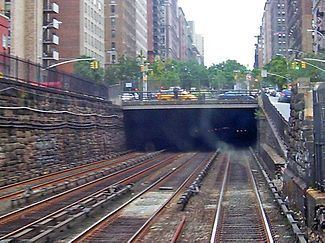 | ||
Similar 145th Street Bridge, Pelham Bay Bridge, Joralemon Street Tunnel, University Heights Bridge, Joseph P Addabbo Memorial | ||
The Park Avenue Tunnel carries four tracks of the Metro-North Railroad underground from Grand Central Terminal at 42nd Street to a portal at 97th Street in the New York City borough of Manhattan. The tracks rise to a full viaduct by 99th Street.
Contents
History
The New York and Harlem Railroad first opened a horsecar line on this route to Harlem station at 125th Street in 1837. The New York Central and Hudson River Railroad lowered the tracks into the 600 feet (180 m) passage which was originally known as the Yorkville Tunnel, built from 1872 to 1876 through Mount Pleasant from 59th to 96th Street, concurrent with the construction of Grand Central Depot. However, as train traffic to Grand Central increased dramatically to the end of the 19th century, the operation of steam locomotives in the tunnel resulted in both an extremely unpleasant experience for riders and a dangerously low level of visibility for train engineers.
On the morning of January 8, 1902, an express train from White Plains missed a number of signals in the tunnel and plowed into a stopped train waiting to enter Grand Central, killing 15 people and injuring dozens more in what was then the worst railroad accident in New York City history. The resulting public outcry led to calls for electrification of the line and replacement of the then-overcrowded Grand Central Depot.
Between 1903 and 1913, Grand Central Depot was demolished in phases and replaced with the current Beaux Arts-style Grand Central Terminal. As part of the project, the rail yard and the approach from 59th Street were placed underground and electrified. Electric locomotives were placed in regular passenger service in January 1907. With the elimination of the noise and pollution from steam locomotives, this once undesirable section of Park Avenue and the land freed by the burial of the rail yard became prime New York City real estate. The idea to place the rail yard below Park Avenue and construct buildings above is credited to William J. Wilgus, the chief engineer of the New York Central and Hudson River Railroad.
Abandoned stations
Along the tunnel are three former stations, located at 59th Street, 72nd Street, and 86th Street, each of which had side platforms on the two outer tracks. These are now used for storage and emergency exits. None of the stations' platforms are more than 172 feet (52 m) long, making them too short for contemporary trains to use. While the 59th Street and 72nd Street stations had typical side platforms located on the outside of all four tracks (i.e. trains on the outer tracks opened their doors on the right), the 86th Street station had two platforms located in between the outside tracks and the center pair of tracks, creating side platforms that resembled walled-off island platforms. This is similar to the layout at 14th Street–Sixth Avenue, except the platforms are walled off from the center tracks, so that trains on the outer tracks opened their doors on the left, and trains on the inner tracks bypassed the station.
